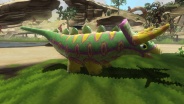Difference between revisions of "Choclodocus"
m (moving * Direct this Pinata to any others to instantly fill their candiosity meter. from other info to uses) |
FeralKitty (talk | contribs) m (Uses = what other species make use of this pinata (e.g., present in the garden, or eaten) to meet a requirement or to variant.) |
||
| Line 68: | Line 68: | ||
== {{PAGENAME}} uses == | == {{PAGENAME}} uses == | ||
| − | * | + | * ???. |
| Line 86: | Line 86: | ||
<!-- List other details not included above, such as effects of accessories, or anything the species produces that can be sold for coins. --> | <!-- List other details not included above, such as effects of accessories, or anything the species produces that can be sold for coins. --> | ||
| + | * Direct this Pinata to any others to instantly fill their candiosity meter. | ||
* The Choclodocus can be placed in a crate and sent to your [[Post Office]]. | * The Choclodocus can be placed in a crate and sent to your [[Post Office]]. | ||
* The amber gem cannot be placed in a crate. | * The amber gem cannot be placed in a crate. | ||
Revision as of 08:13, 26 September 2008
| Choclodocus | |
|---|---|
| Animal: | Diplodocus |
| Candy: | Chocolate |
| Level: | 11 |
| Base value: | 11000 coins |
| Attack: | Nautilus shells |
| Housing | |
| ??? | |
| Housing cost: | N/A |
Were there prehistoric Pinatas? I thought Pinatas were discovered in China by Marco Polo who then brought them to Europe. The tradition then transferred to South America by Spanish explorers. All this was a long time after dinosaurs. It's as if someone wanted be cool without thinking it through properly.
Trouble in Paradise - Standard requirements
To obtain the Choclodocus, you must first get three bones. The blue and green bones can be unearthed from a mine, and the red bone can be purchased from Costolot's General Store after reaching level 45.
Next you need an Amber Gem. This is retrieved from the Wishing Well which can also be purchased from Costolot's General Store, but only after you view the credits from the main menu of the game. You must place the Wishing Well, and then throw 9,999 chocolate coins down the well.
Then you must tinker three colored bones. The order in which they are tinkered determines the type of Choclodocus that will be hatched.
When you're ready to make the dino, the order you have them "tinkered" with decides what dino you get...
The first bone you tinker turns into a skull, which determines the type of head your Choclodocus will have
- Red Bone - Triceratops
- Blue Bone - Stegosaurus
- Green Bone - Brontosaurus
The second bone bone you tinker turns into ribs, which will determine the type of tail
- Red Bone - long tail
- Blue Bone - spikey tail
- Green Bone - stubby tail
The third bone bone you tinker turns into a spine, which determines the color
- Red Bone - Purple
- Blue Bone - Blue
- Green Bone - Green
 Red bone |
 Blue bone |
 Green bone |
Place the skull, ribs, spine, and the amber gem into a Store House. Eventually they will fuse into a Choclodocus egg. This egg can be hatched by a Cluckles wearing a Jurrasic Hair accessory.
The newly-hatched Choclodocus will be a baby, but won't cocoon on its own. To mature it into an adult, you will need to feed the young Choclodocus a bottle of milk, a bone, a Geckie, a Cocoadile, and a Jameleon. Shortly after eating all five items, the Choclodocus will cocoon, then emerge as a quite larger adult.
Trick requirements
Choclodocus uses
- ???.
Species conflicts
- Will frighten away any sours that enter the garden.
Happiness tips
- ???.
Other information
- Direct this Pinata to any others to instantly fill their candiosity meter.
- The Choclodocus can be placed in a crate and sent to your Post Office.
- The amber gem cannot be placed in a crate.

